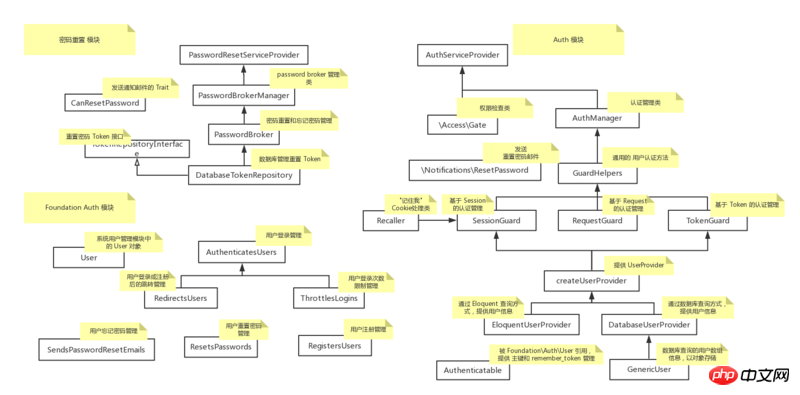This article is based on the analysis and writing of the localization module code of Laravel 5.4 version; I hope it can help everyone learn the Auth module better.
Module composition
The Auth module is functionally divided into two parts: user authentication and permission management; in terms of file composition, the Illuminate\Auth\Passwords directory is for password reset or A small module for forgetting password processing. Illuminate\Auth is the module responsible for user authentication and permission management. Illuminate\Foundation\Auth provides a series of specific logic implementations such as login, password modification, and password reset;
Next The figure shows the relationship between the various files of the Auth module and gives a brief description;

User Authentication
HTTP itself is stateless, usually in the system During the interaction process, use the account or Token identification to determine the authenticated user;
Configuration file interpretation
return [
'defaults' => [
'guard' => 'web',
...
],
'guards' => [
'web' => [
'driver' => 'session',
'provider' => 'users',
],
'api' => [
'driver' => 'token',
'provider' => 'users',
],
],
'providers' => [
'users' => [
'driver' => 'eloquent',
'model' => App\User::class,
],
],
],
];
Copy after login
Understand from bottom to top;
-
Providers is an interface that provides user data, and the driver object and target object must be marked; here, the key name users is the name of a set of providers, driven by eloquent, and modal is App\User::class;
The guards part is configured for the authentication management part; there are two authentication methods, one is called web, and the other is api; web authentication is based on Session interaction, and the user ID is obtained based on the sessionId. In the users provider Query out this user; api authentication is based on token value interaction, and also uses the users provider;
defaults item shows that web authentication is used by default;
Authentication
Session binding authentication information:
// $credentials数组存放认证条件,比如邮箱或者用户名、密码
// $remember 表示是否要记住,生成 `remember_token`
public function attempt(array $credentials = [], $remember = false)
public function login(AuthenticatableContract $user, $remember = false)
public function loginUsingId($id, $remember = false)
Copy after login
HTTP basic authentication, the authentication information is placed in the request header; subsequent requests are accessed through sessionId;
public function basic($field = 'email', $extraConditions = [])
Copy after login
Only authenticates in the current session, and does not record authentication information in the session:
public function once(array $credentials = [])
public function onceUsingId($id)
public function onceBasic($field = 'email', $extraConditions = [])
Copy after login
During the authentication process (including registration, forgotten password), the defined events are as follows:
| Event name |
Description |
##Attempting | Attempt to verify event |
Authenticated | Verification passed event |
Failed | Verification failed event |
Lockout | The number of failures exceeds the limit, lock the request to access the event again |
Logi | When logging in successfully through 'remember_token' , the event called |
Logout | User exit event |
Registered | User registration event |
还有一些其他的认证方法:
检查是否存在认证用户:Auth::check()
获取当前认证用户:Auth::user()
退出系统:Auth::logout()
密码处理
配置解读
return [
'defaults' => [
'passwords' => 'users',
...
],
'passwords' => [
'users' => [
'provider' => 'users',
'table' => 'password_resets',
'expire' => 60,
],
],
]
Copy after login
从下往上,看配置;
重置密码的调用与实现
先看看Laravel的重置密码功能是怎么实现的:
public function reset(array $credentials, Closure $callback) {
// 验证用户名、密码和 token 是否有效
$user = $this->validateReset($credentials);
if (! $user instanceof CanResetPasswordContract) {
return $user;
}
$password = $credentials['password'];
// 回调函数执行修改密码,及持久化存储
$callback($user, $password);
// 删除重置密码时持久化存储保存的 token
$this->tokens->delete($user);
return static::PASSWORD_RESET;
}Copy after login
再看看Foundation\Auth模块封装的重置密码模块是怎么调用的:
// 暴露的重置密码 API
public function reset(Request $request) {
// 验证请求参数 token、email、password、password_confirmation
$this->validate($request, $this->rules(), $this->validationErrorMessages());
// 调用重置密码的方法,第二个参数是回调,做一些持久化存储工作
$response = $this->broker()->reset(
$this->credentials($request), function ($user, $password) {
$this->resetPassword($user, $password);
}
);
// 封装 Response
return $response == Password::PASSWORD_RESET
? $this->sendResetResponse($response)
: $this->sendResetFailedResponse($request, $response);
}
// 获取重置密码时的请求参数
protected function credentials(Request $request) {
return $request->only(
'email', 'password', 'password_confirmation', 'token'
);
}
// 重置密码的真实性验证后,进行的持久化工作
protected function resetPassword($user, $password) {
// 修改后的密码、重新生成 remember_token
$user->forceFill([
'password' => bcrypt($password),
'remember_token' => Str::random(60),
])->save();
// session 中的用户信息也进行重新赋值
$this->guard()->login($user);
}Copy after login
“忘记密码 => 发邮件 => 重置密码” 的大体流程如下:
点击“忘记密码”,通过路由配置,跳到“忘记密码”页面,页面上有“要发送的邮箱”这个字段要填写;
验证“要发送的邮箱”是否是数据库中存在的,如果存在,即向该邮箱发送重置密码邮件;
重置密码邮件中有一个链接(点击后会携带 token 到修改密码页面),同时数据库会保存这个 token 的哈希加密后的值;
填写“邮箱”,“密码”,“确认密码”三个字段后,携带 token 访问重置密码API,首页判断邮箱、密码、确认密码这三个字段,然后验证 token是否有效;如果是,则重置成功;
权限管理
权限管理是依靠内存空间维护的一个数组变量abilities来维护,结构如下:
$abilities = array(
'定义的动作名,比如以路由的 as 名(common.dashboard.list)' => function($user) {
// 方法的参数,第一位是 $user, 当前 user, 后面的参数可以自行决定
return true; // 返回 true 意味有权限, false 意味没有权限
},
......
);Copy after login
但只用 $abilities,会使用定义的那部分代码集中在一起太烦索,所以有policy策略类的出现;
policy策略类定义一组实体及实体权限类的对应关系,比如以文章举例:
有一个 Modal实体类叫 Post,可以为这个实体类定义一个PostPolicy权限类,在这个权限类定义一些动作为方法名;
class PostPolicy {
// update 权限,文章作者才可以修改
public function update(User $user, Post $post) {
return $user->id === $post->user_id;
}
}Copy after login
然后在ServiceProvider中注册,这样系统就知道,如果你要检查的类是Post对象,加上你给的动作名,系统会找到PostPolicy类的对应方法;
protected $policies = [
Post::class => PostPolicy::class,
];
Copy after login
怎么调用呢?
对于定义在abilities数组的权限:
当前用户是否具备common.dashboard.list权限:Gate::allows('common.dashboard.list')
当前用户是否具备common.dashboard.list权限:! Gate::denies('common.dashboard.list')
当前用户是否具备common.dashboard.list权限:$request->user()->can('common.dashboard.list')
当前用户是否具备common.dashboard.list权限:! $request->user()->cannot('common.dashboard.list')
指定用户是否具备common.dashboard.list权限:Gate::forUser($user)->allows('common.dashboard.list')
对于policy策略类调用的权限:
当前用户是否可以修改文章(Gate 调用):Gate::allows('update', $post)
当前用户是否可以修改文章(user 调用):$user->can('update', $post)
当前用户是否可以修改文章(用帮助函数):policy($post)->update($user, $post)
当前用户是否可以修改文章(Controller 类方法中调用):$this->authorize('update', $post);
当前用户是否可以修改文章(Controller 类同名方法中调用):$this->authorize($post);
指定用户是否可以修改文章(Controller 类方法中调用):$this->authorizeForUser($user, 'update', $post);
有用的技巧
获取当前系统注册的权限,包括两部分abilities和policies数组内容,代码如下:
$gate = app(\Illuminate\Contracts\Auth\Access\Gate::class);
$reflection_gate = new ReflectionClass($gate);
$policies = $reflection_gate->getProperty('policies');
$policies->setAccessible(true);
// 获取当前注册的 policies 数组
dump($policies->getValue($gate));
$abilities = $reflection_gate->getProperty('abilities');
$abilities->setAccessible(true);
// 获取当前注册的 abilities 数组
dump($abilities->getValue($gate));Copy after login
相关推荐:
Laravel5.3如何通过公共的auth模块验证不同表中的用户
The above is the detailed content of Detailed explanation of Auth module examples in Laravel. For more information, please follow other related articles on the PHP Chinese website!






